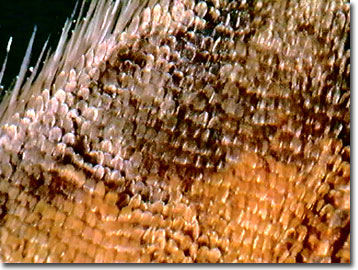Butterfly Wing Scale Digital Image Gallery
Tiger Mimic Butterfly
The tiger mimic butterfly, alternatively known as Mechanitis polymnia, is a highly variable species that imitates the tiger-striped pattern of butterflies in three different genera. The variation of tiger mimics inspired a change in the belief systems of Victorian biologists. Instead of continuing to solely concentrate on fixed species, the scientists began considering issues such as natural selection, phenotypic shifts in natural populations, and the evolution of new species.

There are nine recognized subspecies of tiger mimic butterfly. However, no matter what its wing pattern, coloration, or sex, a tiger mimic butterfly can be identified by a characteristic round spot on the upper side of its forewings. The tiger mimic is the most widespread and abundant butterfly species in Costa Rica, where it can be observed flying on a regular basis in every city. Considered a weak flier, the boldly colored lepidopteran tends to frequent wind-sheltered areas. The tiger mimic, which is sometimes called the sweet oil butterfly, is unpalatable and extremely toxic to vertebrate predators. Thus, the species is beneficial to its fellow mimicry ring members because it reinforces avoidance behaviors in predators.
During the larval stage, tiger mimics feed in groups on the leaves of nightshades, especially the potato, eggplant and common nightshade, which are known for their toxic compounds. The larvae ingest and sequester the compounds that then serve as a defensive mechanism against vertebrate predators. However, they are not protected from parasitic wasps, flies, or spiders. Although not poisonous to predatory ants, tiger mimic caterpillars demonstrate a form of cryptochemistry or chemical camouflage that serves as protection from the insects. Since the caterpillars are able to sequester lipids from nightshade leaves into their cuticles, the larvae are chemically indistinguishable from their hosts and the ants do not recognize them as prey.
The tiger mimic butterfly and other representatives of the tiger-striped mimicry rings are popular with butterfly enthusiasts because of their clear illustration of intraspecific polymorphism and mimicry as a defensive strategy against predatory birds and lizards. Moreover, the slow wing beat of adult tiger mimics makes them easy to view and photograph and, therefore, the species is a favorite at butterfly gardens and conservatories. Unlike many Neotropical butterflies, which are at risk of extinction, the tiger mimic appears to not only be surviving, but also thriving.
Contributing Authors
Cynthia D. Kelly, Shannon H. Neaves, Laurence D. Zuckerman, and Michael W. Davidson - National High Magnetic Field Laboratory, 1800 East Paul Dirac Dr., The Florida State University, Tallahassee, Florida, 32310.
BACK TO THE BUTTERFLY WING SCALE IMAGE GALLERY
BACK TO THE DIGITAL IMAGE GALLERIES
Questions or comments? Send us an email.
© 1995-2025 by Michael W. Davidson and The Florida State University. All Rights Reserved. No images, graphics, software, scripts, or applets may be reproduced or used in any manner without permission from the copyright holders. Use of this website means you agree to all of the Legal Terms and Conditions set forth by the owners.
This website is maintained by our
Graphics & Web Programming Team
in collaboration with Optical Microscopy at the
National High Magnetic Field Laboratory.
Last Modification Friday, Nov 13, 2015 at 01:19 PM
Access Count Since January 21, 2003: 8732
Visit the website of our partner in introductory microscopy education:
|
|
